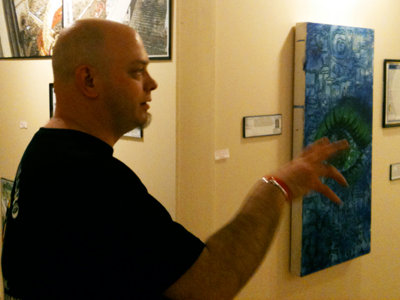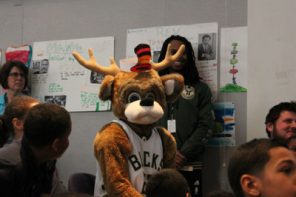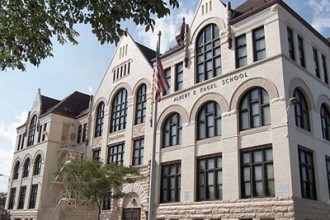At the start of May, Milwaukee’s ArtMail featured the accomplished work of more than a dozen senior art students at Ronald Wilson Reagan College Preparatory High School, 4965 S. 20th St., on the city’s South Side.
That coincided with news that the proposed MPS budget would heavily cut art teachers in the district and led to many impassioned pleas at school board budget hearings to reconsider the move.
Much of the testimony focused on the broad benefits of an arts education.
“It scares me that they’re cutting all of these art courses and it’s completely proven even if it’s not an IB art class, just the creative process increases graduation rates 10-fold,” Reagan art teacher Chad Sperzel-Wuchterl (aka Mr. Chad) tells me on a recent visit to the school to see its impressive art galleries, echoing that testimony.
“So accessing those kids and reaching to those kids, if you don’t supply this even at the minimum level … well, our graduation rates are a problem as it is. And now we’re not even addressing the right brain learners and the multiple intelligences that we know exist and we know improve scores. We’re digressing our education at a time when we should improving it, with the higher class sizes that we’re going to have.”
Sperzel-Wuchterl, has been at Reagan for eight of its nine years of life, where he teaches art, curates the galleries and also does related things like help students produce their annual yearbooks.
The acclaimed Reagan is compelled to offer art to maintain its International Baccalaureate status. Since February it is the state’s only full, four-year IB high school. Walk into one of the two third floor galleries and you can immediately see that Sperzel-Wuchterl and acting principal Mike Roemer take the IB art mission very seriously.
“I’ve been to a lot of schools, all over the state,” says Sperzel-Wuchterl, ” but I’ve never been to a school with a gallery like this.”
The International Baccalaureate program requires that student art be shown in the school.
The senior gallery is in a large space that originally served as two classrooms when the building was opened as Sholes Middle School. When another school occupied part of the building, the rooms were opened up into a single, larger space. Across the hall is the smaller junior gallery.
Both are packed full of impressive student paintings, sculptures and works on paper and are staffed by art students, who are also required to hang their own work in the galleries, which were created about three years ago.
Sperzel-Wuchterl says that while the junior gallery contains works that were created on assignment by students, the senior gallery reflects the freedom that fourth-year students at the school have earned.
“We really make sure that they get all different media in their work,” he says, walking through the senior space. “Senior year I do not assign a project. Senior year is, ‘you’ve got to have five pieces done and what are you going to do? Show me what you’ve got.’
“Junior year is showing them how to put together their sketchbook. Because there are eight categories that just their sketchbook is graded on, between their culture, their artist research, their citation, their ability to use vocabulary in the art field, their ability to bring in connections between what they research and their work.”
While most of the works show some pretty impressive skills, Sperzel-Wuchterl says skills are just one of many components that go into art students’ grades. If you think art class is an easy A or a low-impact educational workout, you didn’t go to Reagan.
“A lot of kids will be like, ‘I can’t do this’,” says Sperzel-Wuchterl, who tells them, “‘Yeah, you can. But I’m going to push you really, really hard.’ Kids in the school know this is one of the most rigorous programs in the school.
“The only reason why we get kids that wouldn’t take art here are for the same reasons why colleges get kids who leave art. They get into it going, ‘Hey I made something in school. That was kind of fun.” But they get into college and it’s, “Oh, my God, this is so much work.” Because you’ve physically got to do it and the kids realize that here. So, kids who leave here and go to MIAD or go to an art program at a university are committed to the arts and are sticking to it. They understand what it takes.”
But getting students to this stage is not easy, says Sperzel-Wuchterl. Sure, he’s concerned what cuts will do to art in MPS in the future, but he knows the situation is far from perfect right now. When he asks incoming freshman if they’ve studied art with a teacher in school and, he says a couple hands go up.
“As far as formal training goes, (there is) next to nothing. You can tell the ones who had it and those who didn’t. And the shame of that is that even those who’ve had it are so far behind. With an international program like this, these guys are held to an international criterion that is the same for America as it is for Europe as it is for Canada as it is for Japan, wherever it is around the world.
“And the Europeans and so many other cultures will take art and center their schools around it from the elementary level and they see it as a core. And even though they’ve had all this their kids are held to the same standard as our kids are.”
Instead of starting at a ninth grade level, much of freshman year is spent on remediation. From techniques and skills to art history and art vocabulary, incoming kids have a lot of catching up to do at Reagan.
“I have to get them from elementary up to high school in four years … actually even college. Some of them get overwhelmed, but it’s not that it’s not do-able. It just takes commitment from the kids, myself, the faculty. Everybody’s got to be on board. If one cog is loose, it’s going to fall.”
The result?
“I’m very proud of my students,” says Sperzel-Wuchterl. “We tend to get the highest scores in the entire school for IB. We either hit or exceed the world average for IB with our work.”
Sperzel-Wuchterl, who seems like a volcano of energy, doesn’t appear to rest. In addition to creating relationships with local colleges and universities that allow his students to study with professors and college art opportunities – like working with live models – he works to bring the community into his program.
This year the art galleries at Reagan hosted a pair of events. The first one, in fall, drew more than 300 people. Sperzel-Wuchterl estimates that the spring gallery show brought more than double that number in to see the work his students are capable of doing.
“I’m always reaching out to get people to show their work,” he says. “It’s good to bring the community into the school, it’s good for kids to see this. It allows people to know that this is more than your typical school gallery. It’s getting bigger and bigger.”
As he looks toward the future, Sperzel-Wuchterl is on edge about how cuts will affect what art looks like at Reagan. Because the art program is a key component of the school’s IB status, he expects it will not disappear. But he also assumes he will have less money to work with in the future.
“It’s going to make me have to fund raise a lot more than I do. I’m going to have to get the word out more. I’m afraid I’m going to have to ask the kids, especially the impoverished kids, to pay a fee for the class. It’s going to change things,” he says.
“We’re planning on me being here next year. I’ve been trained up to level three in IB. So the school and MPS have invested a lot of money into me. Which is nice.”
Long-term, he hopes that the cuts won’t threaten his dream of raising enough money from outside sources to fund an art wing for the school, which would house the studio space, galleries, a technology lab and more.
“It’s my dream to get this done before I can retire,” says Sperzel-Wuchterl.
The public is welcome to visit the galleries during normal school hours. But please call ahead to the office, (414) 304-6100.


 i evaluate to yes even if there's no image
i evaluate to yes even if there's no image  i evaluate to yes even if there's no image
i evaluate to yes even if there's no image  i evaluate to yes even if there's no image
i evaluate to yes even if there's no image  i evaluate to yes even if there's no image
i evaluate to yes even if there's no image  i evaluate to yes even if there's no image
i evaluate to yes even if there's no image  i evaluate to yes even if there's no image
i evaluate to yes even if there's no image 